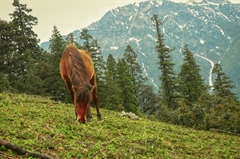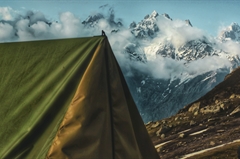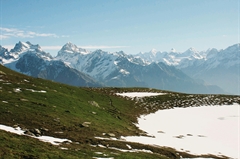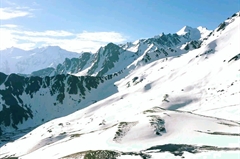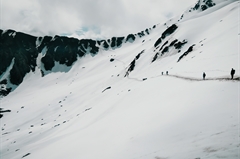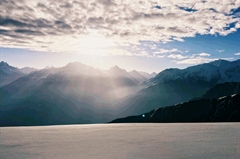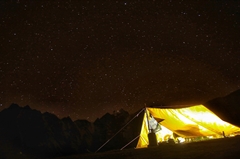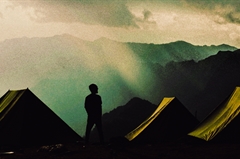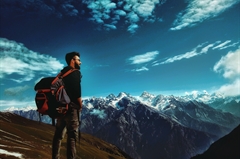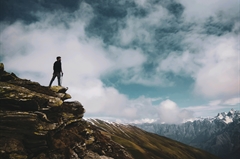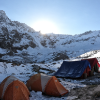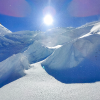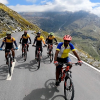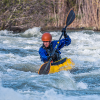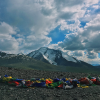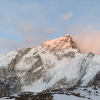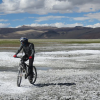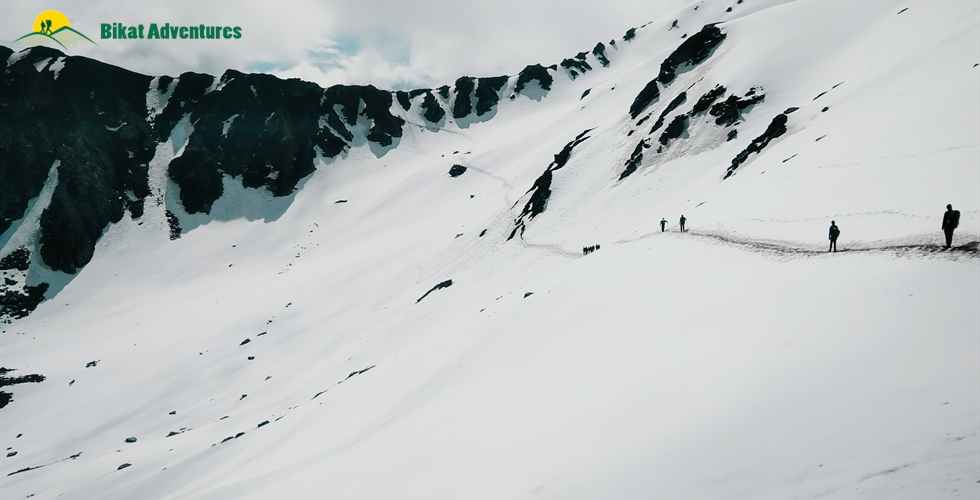
Sar Pass Trek
For all adventure souls who like snow and high mountains
Available Batches
Brief Description
Brief Itinerary
Detailed Itinerary
Day 1
Arrive at Kasol (1,580M) and trek to Grahan (2,300M)
Distance: 8 kms trek
Duration: 5 hours
We assemble at Kasol market by 09:30 AM. Keep enough buffer time in your hand to reach Kasol; these roads are prone to jams and delays. If possible, get here a night before so that your day doesn’t feel too packed and rushed.
From the busy market, we turn a corner and reach the forest which is the starting point of the trek. Here, we do our briefing and distribute your rental + equipment. Packed lunch will be provided, too. There are enough water sources on the way today. We start our trek on the right side of a stream of glacial water which is going to be our companion throughout the day. Once in the forest, the temperature instantly drops by 5 degrees.
You will find small dhabas along the way which serve Maggi, rhododendron juice, biscuits and chai. The first six kilometres of today’s trail is a motorable road but with splashes of green everywhere. The last 2 kms is when we start to ascend on a walking trail to get to Grahan village. The first 6 kms should take us close to 3-4 hours to cover. And the last 2 kms of steep section with a 300M ascent should take us between 1-2 hours.
Expect to reach the homestay between 2 and 3 PM. Settle in and wait for the sunset magic to begin!
Day 2
Grahan (2,300M) to Min Thatch (3,285M)
Distance: 4 kms
Duration: 5 hours
The ascent today is quite massive – close to a 1000M in a short distance of 4 kms. Remember to pace yourself and take it slow to avoid getting sick. We are walking through forests so thick, that you will see the sunlight visibly struggling to make its way to you. Spider webs gleam in the sparse sunlight like holograms. There are no water sources today, carry at least 2l of water with you as you start.
We leave after breakfast at 9 AM. Once we cross the village, we descend for a short while from where we cross a small wooden bridge to get to the other side of the Grahan nalla – it is now all uphill from here. There is a dirt path leading us to Min Thatch. On the rocky, uneven ground, stones and the thick roots of the trees act as makeshift stairs – remember to exercise caution at every step.
At the mark of 1 km, after an ascent of 180M, we reach a small clearing – a patch of almost flat land which is a welcome change. A kilometre and a half more from here, after an ascent of 450M, we reach a dhaba. Packed lunch is provided for today. You can also choose to indulge in some Maggi and omelettes at the dhaba. The food here tends to be a bit on the expensive side – check for prices before you order.
We have half way more to go after this lunch point. The route is on similar terrain. In 2 more hours, we reach a massive meadow with a carpet of the brightest purple wildflowers you ever saw. This is Min Thatch (thatch meaning meadows), our campsite for today, bordered by thick forests and rhododendron bushes to your right and a wide view of the valley and the skies to the left. The sunsets from here are glorious.
Day 3
Min Thatch (3,285M) to Nagaru (3,850M)
Distance: 3 kms
Duration: 3 hours
Today we are heading to the highest campsite of the Sar Pass Trek, Nagaru. We leave by 9 AM. After a 20M ascent, there’s a short patch of flat land. From here on, it is a steep uphill walk. Once we leave the campsite, we quickly cross through the end of treeline on this trek – enjoy the shade while you can because after the first 10 minutes, we are exposing ourselves to the full force of the sun and the winds. After 300M of ascent, we hit the first dhaba for today – this one serves Siddhu (a local Himachali delicacy) in addition to the regulars! We have packed lunch for today as well, but feel free to indulge in some mid-mountain hospitality. Shortly after the dhaba, we reach a section called ‘the rope point’. When there is ample snow, this 70 degrees steep section gets very slippery and very dangerous. We set up ropes at this point as a climbing aid and safety measure. When the landscape is dry, it can be crossed without ropes. After this ascent, follow the rhododendron bushes to stay on trail. After a continuous ascent of 450M, we reach a clearing. You can see the campsite from here. There are only some slippery slopes of ice between you and the safety of your tent now.
The trek today is short but difficult because of the steep ascents. Depending on the season, the trail may be covered in snow or be barren. The campsite at Nagaru has snow at all times. Since it is a wide-open clearing, the winds here can get menacing, hold on to your tents at night! Views of endless rows of snowclad mountains of the Parvati range grace this campsite – the sunsets here are exceptional. The Pass from here is so close, you can see it from your tents!
Day 4
Nagaru (3,850M) to Biskeri Thatch (3,400M) vis Sar Pass (4,223M)
Distance: 8 kms
Duration: 10 hours
Today is the day we reach the Pass we had been admiring since last evening. Even though it looks close, it takes 2-3 hours to get to. The distance is close to 1 km with a 300M gain in altitude. If we hope to catch the sunrise from the top, we leave by 3 AM and start the climb in darkness – expedition style! Get your head torch ready, put on your gaiters and microspikes and be ready by 02:30 AM. We fill our bottles, have some breakfast under the stars and leave. The 2-3 hour ascent is in snow, it is an uphill climb which is quite steep. Take it slow but keep moving to avoid your body from getting cold. We make it to the top of the Pass just as the peaks of Parvati Valley start to take on a golden hue. There’s nothing like the alpenglow of dawn to get the best photos of this wide landscape. In this world of white, take some time to look over and identify some popular peaks. We leave after spending an hour at the top.
The main challenge of the day is the long descent to Biskeri Thatch, our campsite for today. After we cross the massive snow field that is Sar Pass, we descend down for a bit. The path takes us horizontally across the mountain on quite an angled slope. There is one more steep ascent left for the day – the one to Biskeri Top that is almost at the same height as the Pass. After we make our descent and traverse across mountains on a narrow path, we make the steep ascent over slippery terrain all the way to Biskeri Top. This half a kilometre of stretch will only take about 15 minutes to cover but it will definitely knock the air out of us! Once at the top, it is only downhill from here. When it is snowy, we can slide down and save our legs some effort but when the snow has receded, we have to walk down this long slope.
At 4.5 kms, we reach the last dhaba on our trail. From here the route gets easier. Thick with rhododendrons, it is a pleasant walk all the way to Biskeri Thatch. It is a campsite amongst tall trees and singing birds – our last night in tents. The snow-clad mountains give way to jagged, rocky peaks. Welcome to warmth!
Day 5
Biskeri Thatch (3,400M) to Barshaini (2,210M) and drive back to Kasol (1,580M)
Distance: 5 kms
Duration: 3 hours
Today is our last day on the Sar Pass trek. The trail is all downhill through pine forests. The descent is easy towards Pulga and across Parvati River to reach the village of Barshaini. Our team will be waiting at Barshaini to drive you to Kasol. It is a two hour drive - expect to reach Kasol by late afternoon. Plan your journey ahead accordingly.
What's Included
- Veg Food (Day 1 Lunch till Day 5 Breakfast). Three Meals a day.
- Forest Permits/Camping Charges/Permits, Trek Permit Fee/IMF Permission (Upto the amount charged for Indian nationals).
- Camping tents, Temp rated sleeping bags, mattress
- Safety Equipment includes static rescue rope, seat harness, carabiners, pulleys
- Mountaineering course certified Trek Leader with Wilderness Emergency Responder & Rescue.
- First Aid Certified Local guide, cook, helpers
- Porters or mules for carrying common luggage
- Last day transportation from Barshaini to Kasol
What's Not Included
- Meals during road journeys
- Any kind of Insurance
- Any expense of personal nature
- Carriage of personal rucksack
- Meals during Hotel Stay
- Any expense not specified in the inclusion list
Are you Eligible for this Adventure?
BRS Level Required
Although fairly easy, any kind of activity in high altitude requires a certain level of physical fitness and endurance for it to be a pleasant experience.
If you do not know what level of BRS trek would suit you best, worry not! Fill out this Form:
we will send you a progression chart to help you comfortably get out of your comfort zone in order to level up and ultimately reach your highest potential in the big, bad world of outdoor adventure.
Packing List
This is a list of essential items for individuals doing the trek with Bikat Adventures. This list contains only those items which the participants are required to bring with them. The list excludes those items which are provided by Bikat Adventures on the trek. We have divided the items into five categories. All the items in the list are essential except for those marked as optional.
Trekking Gear
- Ruck sack bag with rain cover. Qty -1
- Day Pack Bag - Recommended for treks with summit day
- Head Torch with spare Batteries. Qty -1
- U V protection sunglasses. Qty -1 Here is how you can choose the best sunglasses for trekking.
- Water Bottles: 2 bottles of 1 liter each
Footwear
- Non-skid, deep treaded, high-ankle trekking shoes Qty -1
- Pair of light weight Slipper/Sandals Qty -1
Clothing
- Quick Dry Warm lower or Track Pants. Qty - 2
- Full sleeves T-shirts/ Sweatshirts. 1 for every 2 days of trekking
- Pair of thick woolen socks. 1 pair for every two days of trekking
- Thermal Body warmer Upper & Lower. Qty-1
- Undergarments. Qty - 1 for every day of trekking
- Warm jacket closed at wrist & neck .Qty-1
- Full sleeves sweater. Qty -1
- Rain wear ( Jacket & Pants ) . Qty-1
- Pair of waterproof, warm gloves. Qty-1
- Woolen cap. Qty-1
- Sun shielding Hat. Qty -1
Toiletries
- Personal toiletries kit (Small Towel, Toilet paper, paper soap, Bar soap, toothbrush, toothpaste, cold cream, etc.)
- Sun screen lotion small pack. Qty -1 Here is your Sun Protection 101 to stay safe in the bright sunny outdoors.
- Lip Balm small pack. Qty-1
Utensils
- Small size, Light weight & Leak proof lunch box. Qty-1
- Plate. Qty- 1
- Spoon.Qty-1
- Tea/Coffee (plastic) Mug.Qty-1
Miscellaneous
- Camera (Optional)
- Carry your medicines in plenty in case you have any specific ailment. Consult your doctor before joining the trek.
- Dry fruits, Nuts, Chocolate bars (Optional)
Frequently Asked Questions
(Note: We don’t recommend offloading because the extra resources on a trail - ponies or porters depending on the trail - means extra load on the environment which can easily be avoided. It also goes against the spirit of trekking by eliminating a level of endurance and discomfort from the experience which are factors at the very heart of an outdoor adventure activity.)
Why Bikat?
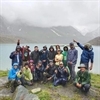

Small Group Size
Our batch sizes are capped at 15 for smaller treks with the trek leader and trekker ratio of 1:8. This ratio, in our years of experience, has proven to deliver the best trekking experience for individuals as well as groups. Capping the size of the group ensures individual attention to each trekker so that no signs of distress or need during the trek go unnoticed. It also helps to form a more cohesive cohort with better group energy which helps define the rhythm and pace of days on the trek. As you go higher up on the BRS scale, since the stakes are higher, expeditions have an even smaller group size with the ratio of expedition leader to climber set at 1:2.
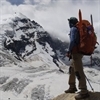

Qualified Trek Leaders
We follow a rigorous regime of hiring and training our experts in the field. Each trek leader is a certified mountaineer with years of experience in the field. In addition to their qualification, they also go through practical and situational training to tackle any and all kinds of sudden conditions that may present themselves on the ground. Being unpredictable is the core nature of the mountains but being ready for any circumstance as best as possible is a controllable asset that we try to nurture. Our field experts are also trained in basic medicine and first-aid response. Watch: Forerunners - The Making of A Trek Leader At Bikat Adventures
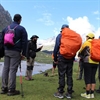

Guided Progression
Since Bikat Adventures is a learning-based organization, we help you climb up the ladder of difficulty within the sphere of outdoor adventure systematically. Our on-ground training modules are designed to handhold you through the upskilling process so that you are ready to take on bigger challenges.
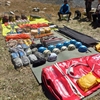

Equipment Quality and Check
All the gear used on our treks and expeditions is tried and tested, maintained for good quality, and is overall top-notch in quality and condition. We are continually looking to obtain the best of everything there is in the market so as to ensure optimum safety.
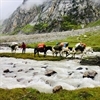

Support Systems
Along with the staff you see on-ground, we have a team of superheroes working in the background to give you the best experience possible. Our background team also comprises local staff from each area who know the region best. Having local support helps with studying the area, pre-planning, execution, and in receiving timely support in case of emergencies in these remote locations.
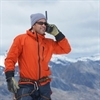

Communication
Our on-field staff is in constant contact with our teams based in primary locations so as to eliminate any avoidable delay in reaching additional help and support when required. We try to use the best tools for communication available, including satellite phones, in regions where they are not restricted.
What our customers Say
Cancellation Policy
Cash refund
Cancellations up to 60 days prior to departure date
Between 60 days upto 30 days prior to departure date
Between 30 days upto 10 days prior to departure date
Less than 10 days prior to departure date
Voucher refund
Cancellations up to 30 days prior to departure date
Between 30 days upto 15 days prior to departure date
Between 15 days upto 10 days prior to departure date
Less 10 days prior to departure date
- Cash refund is applicable only in case of bookings made without using any promotional offer code or Cancellation Vouchers or Discounts
- This is only a brief of cancellation terms. For finer details please refer Detailed Cancellation Policy.
Blog Posts
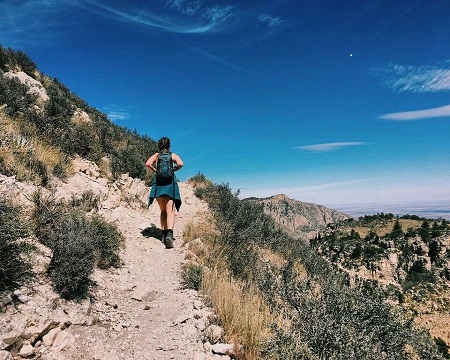
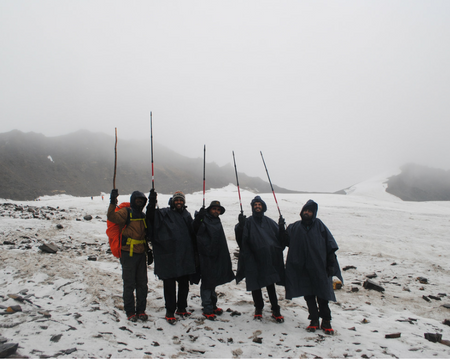
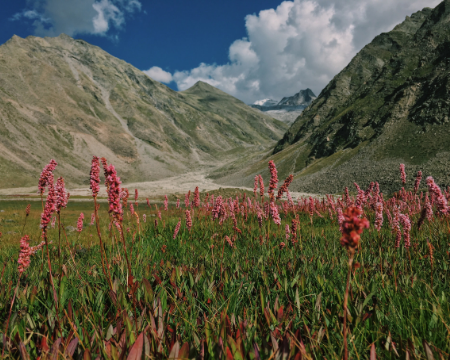

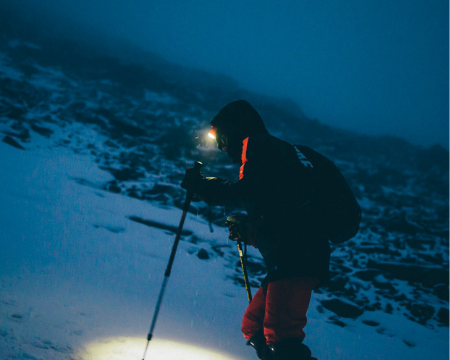
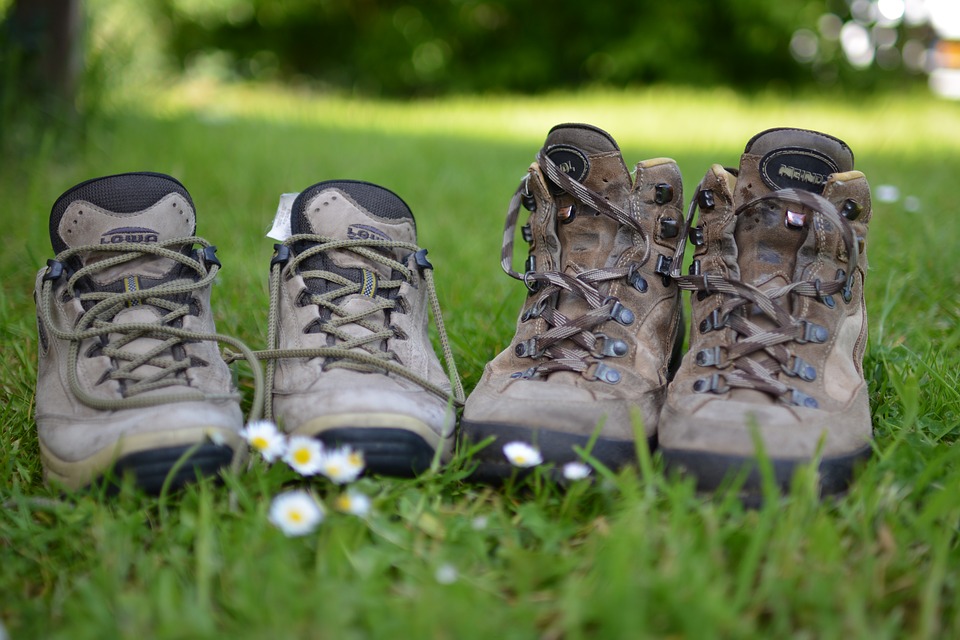
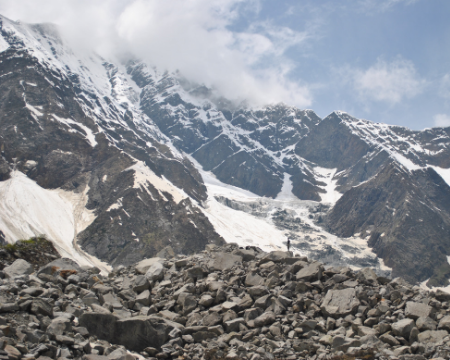
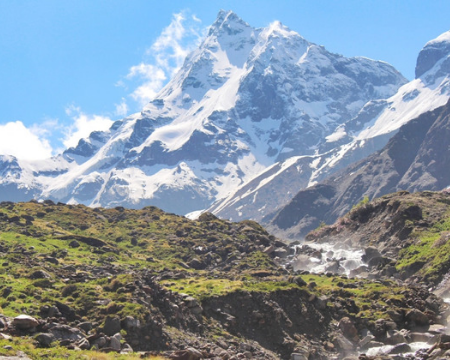
Similar Adventures
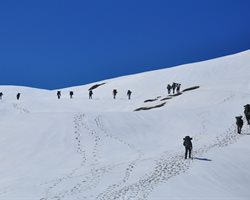
Panwali Kantha Trek
Uttarakhand
5 Days
BRS 3
3500 m
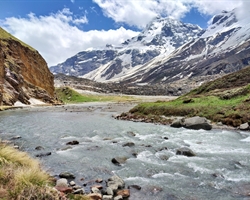
Dev Kyara Trek
Hidden Gem of Uttarakhand
Uttarakhand
7 Days
BRS 4
4100 m
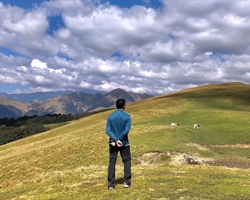
Ali Bedni Bugyal Trek
The Next Chapter of Roopkund
Uttarakhand
6 Days
BRS 3
3535 m
